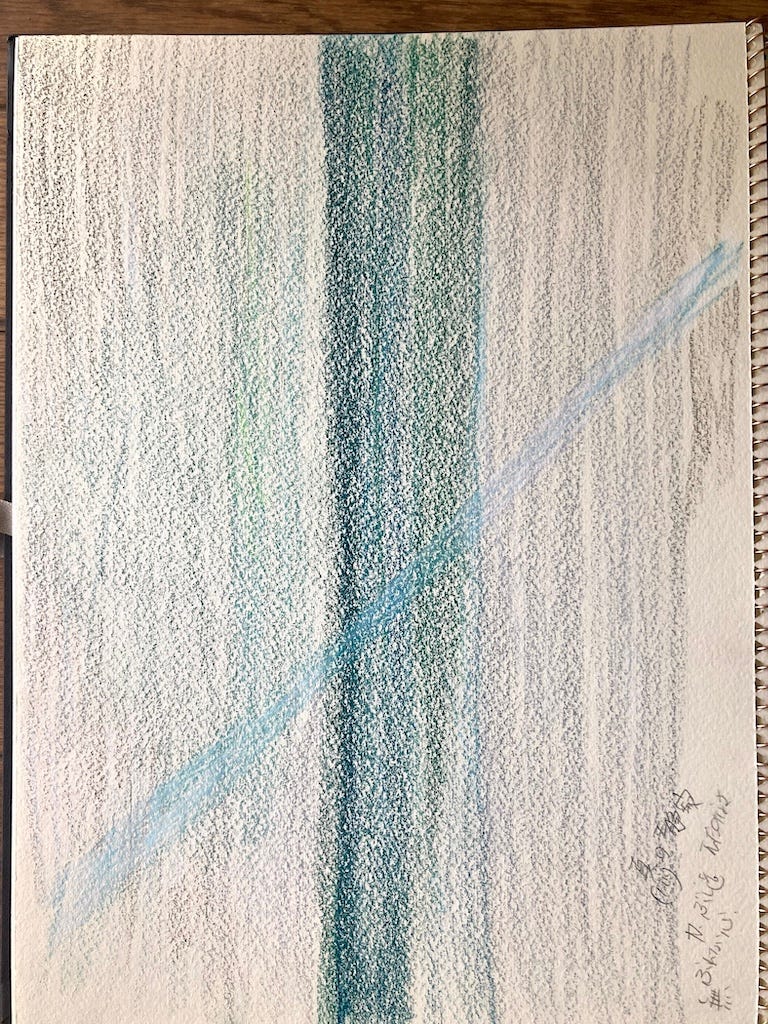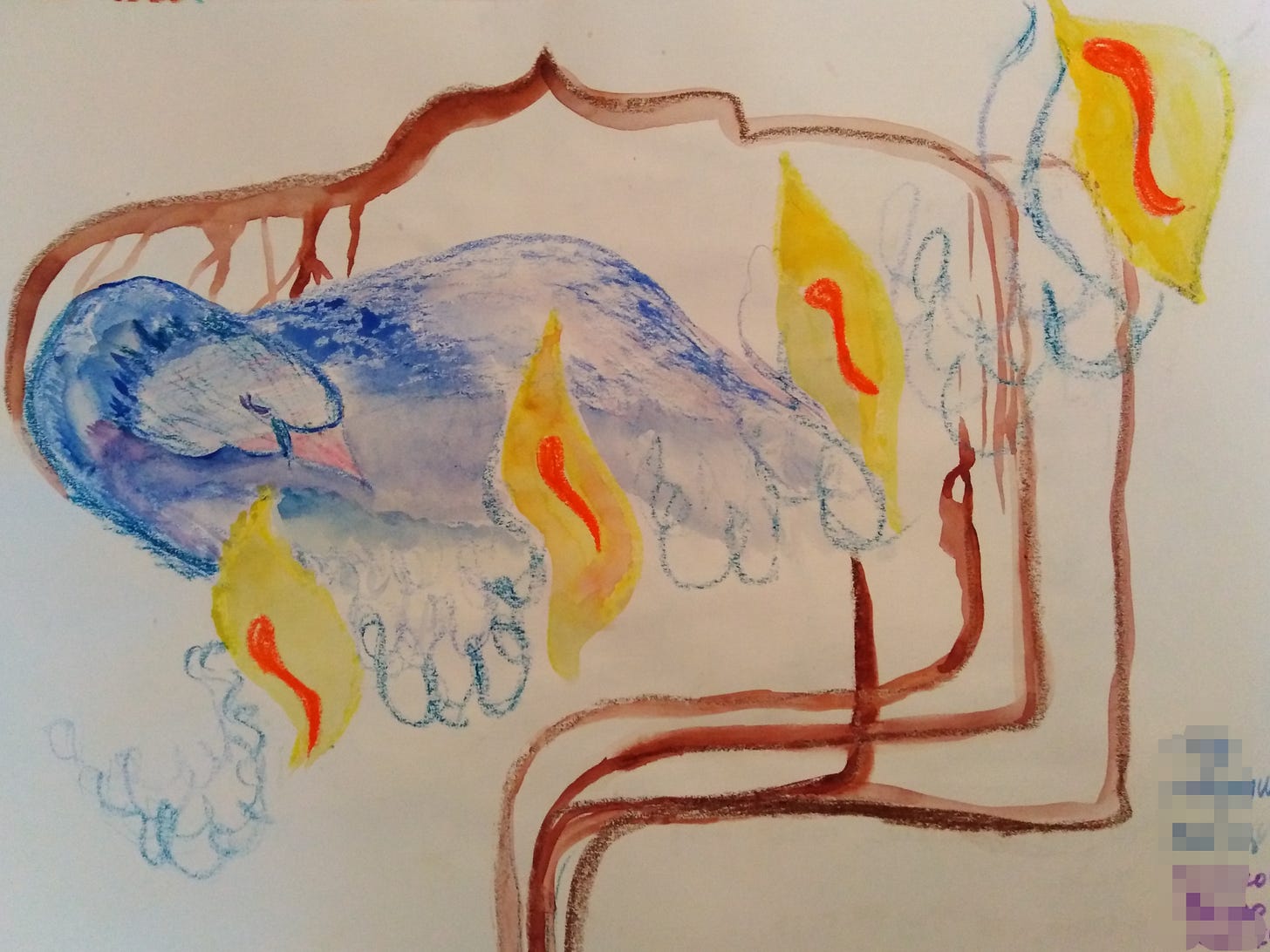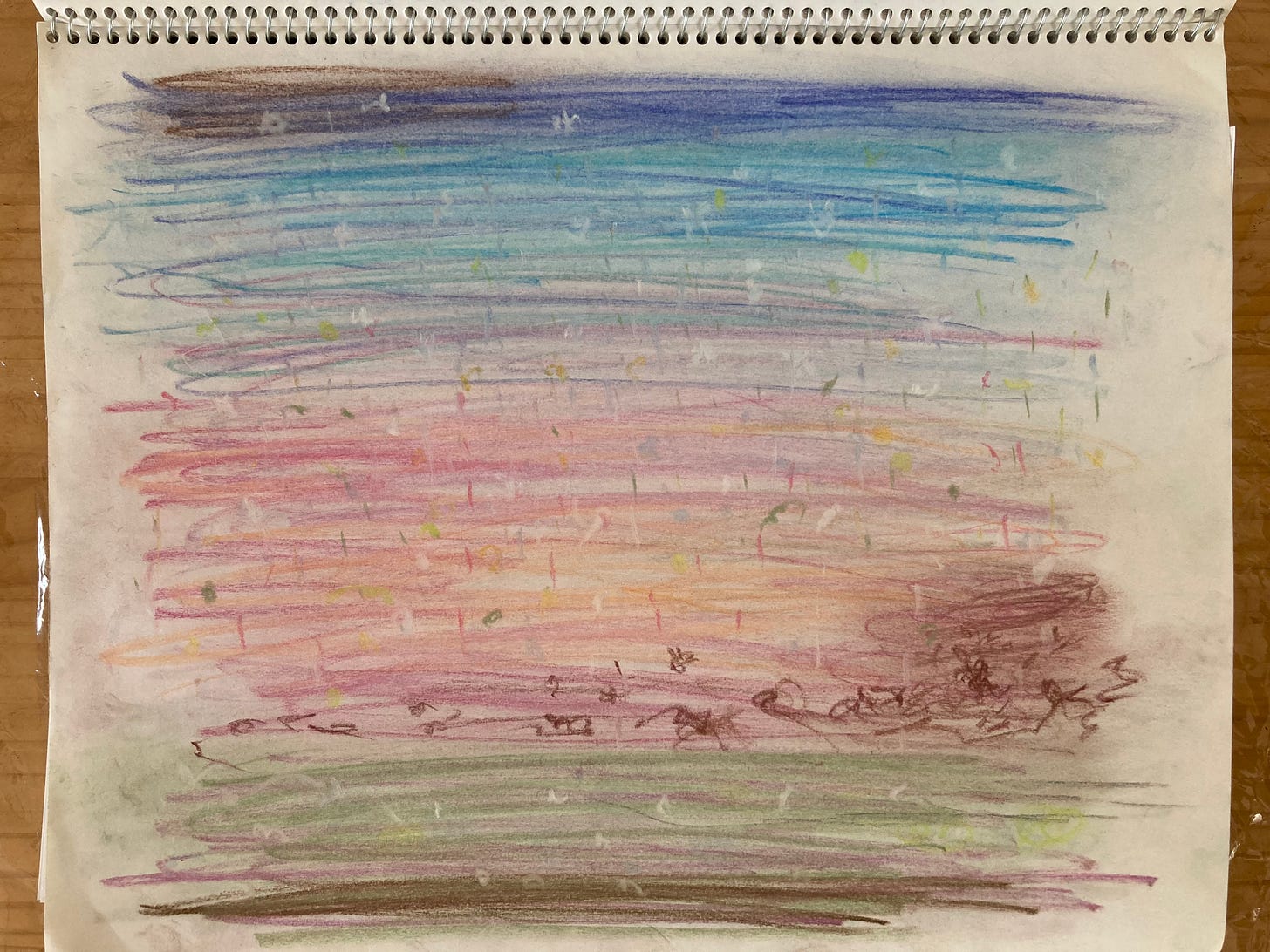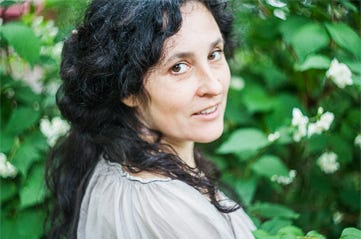MEETING POINT: Expressive Arts As Encounter. Cross-Cultural Art-Based Research. Russian-Japanese session.
By Varvara V. Sidorova PhD, REAT
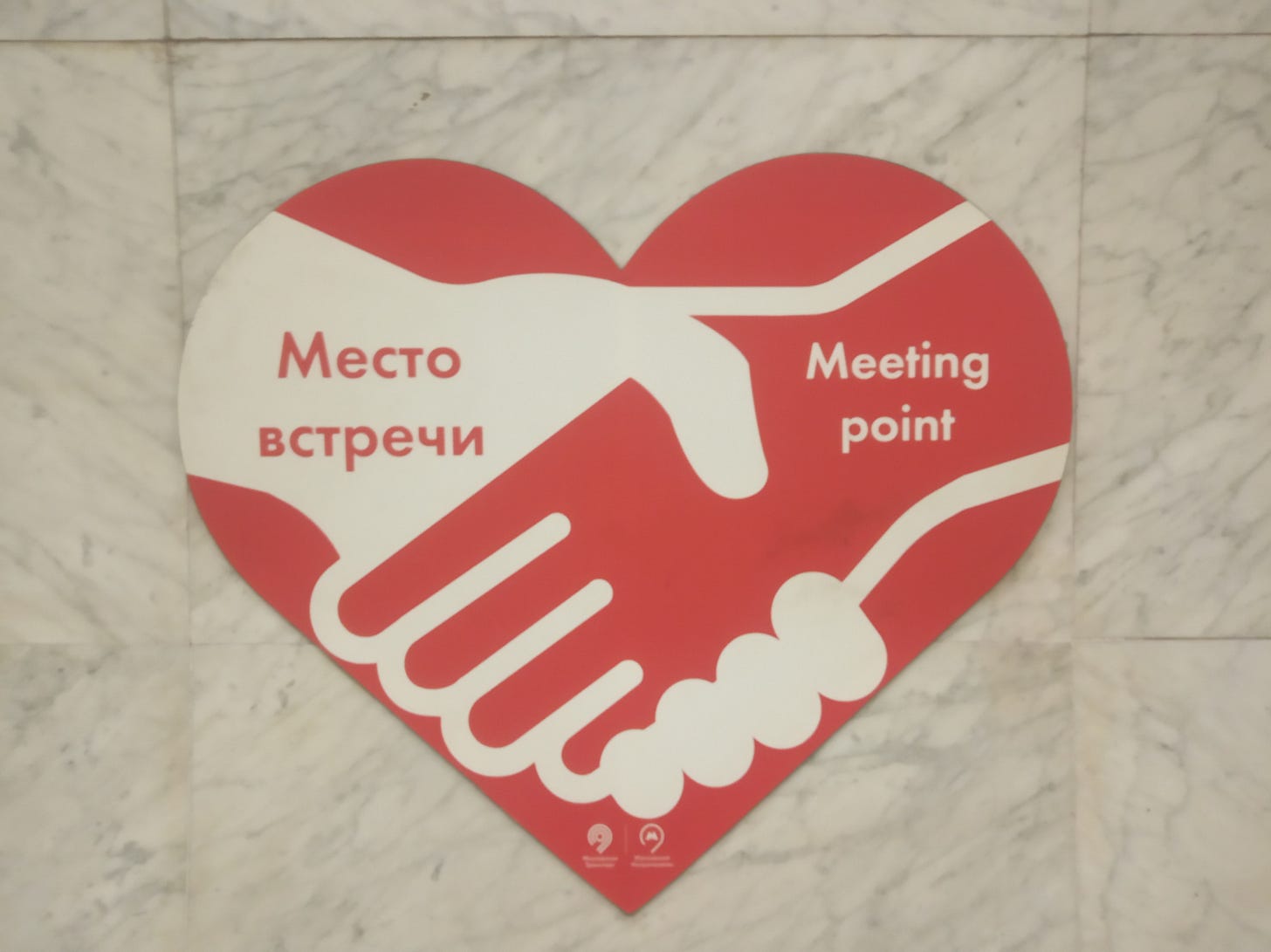
While writing my PhD thesis I initiated within its frame a cross-cultural art-based study which was backed by my colleague educators of intermodal expressive arts therapy from other countries. The Moscow teaching program of expressive arts therapy existing since 2005 based in Moscow State Psychological-Pedagogic University and now private Expressive Arts Therapy Institute “Arts and Consciousness” (Russia) – being a part of International Network of Expressive Arts therapy institutions united by European Graduate School. This study became a scientific research in the field of expressive arts involving partner institutions and calling for free cross-cultural art-based research. All teaching programs included in the International Network of educational centers share the same philosophy and approach to expressive arts. We speak and understand the same language of expressive arts even if our native languages different, as well as cultural and social situations in our countries. Every School adapts its teaching standards in expressive arts to their local situations but the essence of expressive arts remains mutual.
The global situation caused by the pandemic provoked major changes on many levels of consciousness, but, in spite of limitations the pandemic aided our unity and striving towards each other. The online form of teaching and studying expressive arts became that unexpected ‘Third’ which expanded the repertoire of play. If in 2020 we started experimenting inviting foreign teachers for online classes, in 2021 it became possible to meet for students of expressive arts from different countries and programs. And in 2022, due to the dramatic events in Russia, the research acquired even more relevance and scope; it allowed people to meet over their political and ideological views, to meet at their human level, and I am thankful to the participating practitioners of expressive arts from other countries for their openness and courage.
I think that one of the first achievements of this study is the very precedent of meeting at the territory of expressive arts for students studying expressive arts from different countries. The expressive arts became the Meeting Point, the Bridge, the Mirror where one could see and hear another without prejudice and cultural stereotypes staying in clean area of phenomenological meeting. This resulted in strong emotional response from both sides of participants and in experiencing how their cultural ‘bubble’ and stereotypes of commonplace reactions broke, producing the experience of ‘expanding the range of play’ (Knill, Barba, Fuchs,1995) at many levels.
As a result of each session a multilateral dialogue emerged as a conversation with oneself, with others, with alien and own cultures in the language of expressive arts.
Methodology of the study
There are a lot of different research approaches at the junction of psychology and cultures, among them psychological anthropology, cross-cultural psychology, ethnopsychology, cultural psychology et al. All of them deal with different aspects of the massive body of culture and psychology.
In my first PhD thesis dedicated to cultural determination of the image of consciousness I conducted research at the junction of cross-cultural and cultural psychology. Participants of research were Russians and Japanese as well as Russian and Japanese emigrees to the USA and the control group of USA dwellers for a few generations. It was an important discovery that emigrees transfer their way of building the image of consciousness peculiar to each culture. (Sidorova, 2005). It turned out that the way of building one’s image of consciousness is determined by culture, that for the Japanese it is more typical to build an image of consciousness based on objective reality, while for the Russians the sensual fabric of meaning came to the fore, or, in other words, the Russian way of building an image of consciousness mostly employed abstract concepts, rather ideas than objects. This research also helped myself to understand culture specific work of consciousness of Russians exactly thanks to comparison with a different culture.
In the current study my aim is not to identify and describe specific differences, to somehow juxtapose and compare different highlighted categories, as it was done in my first classic and academic study using the method of quantitative research. Rather, my goal is to create and describe with the help of art the phenomenon of meeting of representatives of different cultures at the territory of expressive arts. It may be said after Shaun McNiff and Paolo Knill that it is an art-indigenous aboriginal research of our cultural identity in the language of arts. In this sense it may be called an analysis in the language close to the language of art employing aesthetic methods and art-based and expressive-arts-based methods of research.
I propose in this research to use art and expressive arts as the place and the means of meeting for representatives of different cultures. I undertake cross cultural art-based research, an important part of which is not only the result and the acquired data but also the very process of exploration representing multilateral meeting with oneself through Another or another culture, as the analysis of visual products and description of discoveries, or ‘the Third’ (Knill) occurred during the work. Understanding oneself is impossible without Another. Consciousness is initially intersubjective, says Husserl, but in the same time experiencing Another is not given us directly; there is a different life of consciousness beyond moves, and, more, manifestations of Another. (Husserl,2009). It is a practically impossible mission to let Another into one’s experience in such way that this Another spoke not about myself but stayed a different Another. How can we leave Another to Another? The meeting always occurs within the experience of my consciousness, but at the same time this My consciousness cannot exist without experiencing Another.
We rest on the methodology of art-based studies (P. Levy, Shaun McNiff) and, primarily, on the understanding that the researcher himself becomes an artist, or creator, plunging into the field of art-experience. Also, we, as well as possible, tried to avoid analyzing the data but instead stay with the process of research. Methods of art-based research are supplemented by the method of expressive-arts-based research (J. M. Calderon), from the point of view of which, as we mentioned before, the discoveries made in course of the work – ‘The Third’ (Knill, Barba, Fuchs, 1995) – are as well the data of the research.
Another philosophic basis of the research is the philosophy of methodology, above all, a vision of Another. The vision of reduction of experience layers, including close scrutiny of cultural experience layers, gives us the opportunity to reduce one of the levels of our cultural identity in order to step on a higher level – the level of panhuman experience. Thus, in course of the process the participants could sense different levels of their identities: 1) personal and individual; 2) cultural as determined by ties with this or that culture; 3) panhuman, or universal level. But this reduction did not drive one to wipe out or loose one’s own unique culture, rather, on the contrary, it expressed itself through acknowledgement of one’s own uniqueness and the uniqueness of another one.
Research form
We were focused on art-based research through traditional musical art forms. In modern culture eroded by globalization meeting with one’s native traditional culture may conceal multiple discoveries related to implicit self-identity and with certain hidden knowledge which frequently is not perceived by commonplace conscience. It is especially felt in nationally homogeneous societies and cultures. For instance, in Russia the Russians comprise over 70 per cent of population, therefore, as the saying goes, a fish doesn’t feel water when in water, so here culturally definite way of communication, the language, self-identification in a homogeneous culture are so strong and natural that it is possible to understand one’s singularity only after experiencing culture shock of getting out of one’s native cultural environment through the meeting with a foreign culture. The very fact of meeting otherness gives birth to many perceptions concerning one’s own identity. On the other hand, even in homogeneous societies, because of globalization and disassociation with traditional cultures, meeting on the territory of arts with an art-form born in one’s native culture may become an important basis to build up one’s cultural identity and to connect with one’s roots.
Musical modality was chosen as the simulative modality. We organized nine group sessions the participants of which were proposed to give aesthetic responses and communicate on the territory of expressive arts. The participants of the research were mostly the students of educational programs in intermodal expressive arts therapy. The goal of the research was, among all, to watch how interaction with culturally familiar and foreign art-forms occurs and to trace responses produced by the same art-forms in different culture groups. So, we are trying to expose and describe certain similar states of consciousness provoked by one or other culture and draw a conclusion about the possibility to use culture-oriented art-forms in the context of expressive arts therapy. Thus, we continue to study consciousness through arts and arts through consciousness and expressive arts.
Every time during this study, when a representative of an institution and I chose a music sample we felt aesthetic responsibility as educators and therapists, on one hand, and as representatives of our native cultures on the other hand. Only traditional music played by traditional instruments or traditional vocals was chosen. Thus, because the Russian musical tradition is better preserved in songs I chose Russian folk songs by different performers. During the meeting with the Indian group a sample of traditional Indian raga for sitar, tabla and flute was proposed. A sample played by Chinese flute was used during the meeting with a group from Hong Kong.
Deliberate addressing to research of traditional music cultures was also chosen as a part of decolonization movement. We know that European colonization is distinct in the field of music and musical education worldwide. Where the European musical tradition was actively implanted, indigenous musical traditions were eradicated as we can see in Russian history – eradication of Russian musical tradition by Peter the Great and bringing in European music.
At the start of research, I hoped to get an answer to the question whether a sample of traditional music can convey certain cultural peculiarity as felt and heard by everyone. But in course of research my interest moved from configuration of sounds to the most powerful capacity of expressive arts to build dialogue on human level above all differences, while acknowledging and accepting Another with interest and curiosity, not trying to record and fixate differences.
We also tried to leave open space in our study so as to have maximum place for multilateral dialogue with oneself, with others, and with the world through expressive arts, which always are essentially a conversation and self-study, because whatever we study we study ourselves.
The course of the art-based study
Meeting of groups online and the ritual of presentation with a name gesture.
Onetime listening to the 1st music sample.
Listening to the 1st music sample for a second time with an invitation to respond to it in a dance.
Drawing after the dance and the hearing – images, impressions, lines, forms.
Proposal to write down 5 words accompanying the drawing and answering to the question what surprised me.
Pause
Listening to the 2nd music sample.
Listening to the 2nd music sample for a second time with an invitation to respond with a dance to this music.
Drawing after the dance and the hearing – images, impressions, lines, forms.
Proposal to write down 5 words.
Meeting in session rooms in pairs or mini-groups. In each pair or mini-group representatives of both cultures were present. They were proposed to tell about their drawings and share their experience in movements or dances, share their aesthetic responses.
Return to the common group and proposal to write a poem combining the first and the second 5 words and including the aesthetic response, proposal to write a poem combining the live experiences of both music samples.
Sharing in the big group including poetic sharing. Answering the questions: What surprised me? What have I discovered during this study? What was ‘the Third’?
Closing ritual.
Filling the research form.
In advance to the meeting each participant got a mailed invitation to the study with information consent for documenting the meeting, zoom-video recording and consent to share the data of the research.( see in appendix After the meeting all the participants filled the Google feedback form and sent their drawings and poems as data. What was your personal discovery? What have you learned about yourself?
Chronology of the meeting and the number of participants
In course of the study 8 cross-culture sessions were conducted online with duration 1.5 to 3 hours. 9 to 50 people took part in every meeting. The overall number of participants in the cross-cultural art-based research was over 191 people from 8 countries. In this article I describe the Russian-Japanese session.
Session 5. Russian-Japanese session
Date: 03.04.22
Duration: 3 hours
Session format: Online Video Recording
Partner institution: A course of nature-oriented therapy with arts guided by Markus Scott Alexander (Canada) with the organizing assistance mediation of Mariko Hoshizumi.
Number & content of participants: 7 representatives of Japanese culture and 8 Russian participants of the study. A Russian-Japanese interpreter also took part in the meeting.
Musical fragments:
Russian lullaby “How upon the sea..” performed by Agraphena Glinkina
Japanese musical fragment for the Shakuhachi flute
Description of the session process and the response of the researcher.
The Russian-Japanese meeting took place on April 4, 2022, six weeks after the beginning of the Russian ‘special operation’ in Ukraine. It was a very troublesome time for the Russian participants. I am grateful to Mariko and the Japanese part that the meeting was conducted in spite of the sanctions against Russia. However, a number of precautions was taken by the Japanese side, such as video recording and data collection made by the Japanese side. In general the contacts with the Japanese group were organized on a high level. Mariko Hoshizumi made a table, with translation into English of all the responses of the Japanese participants. I am grateful to Mariko Hoshizumi for her help and to Markus Scott Alexander for the contact.
The session was conducted with the assistance of a specially invited Russian-Japanese interpreter. At once, during the introduction ritual of the participants, a very subtle and delicate atmosphere of attunement and deep interest in one another aroused. The possibility to articulate and repeat with a gesture the name of another person brings unity.
The Russian musical fragment was the first to hear, we already hear this song in the beginning of our research with Indian group, and this time the lullaby sounded differently, it touched and bruised the soul, as if the territory of the Russian identity was not calm after the February 24, and the music was not perceived as calm.
It was a great consolation for me and the other Russian participants that, according to their reactions, they acquired this calm and safe territory again in the responses to the Russian fragment of Japanese participants. Reflected in their eyes and their hearts, we could hear again that it is okay with this music, that the love that had been in it, was still in its place.
It was also important for us to hear from the Japanese participants such responses to the Russian lullaby performed by Agraphena Glinkina as ‘The world that becomes a home’, ‘I believe’, ‘Love embraces all”. After listening to the Japanese fragment it seemed that all the emotions aroused by our native music calmed down. Mariko Hoshizumi and I chose for the Japanese musical fragment a composition for the Shakuhachi flute. Personally for me it is very well known, almost home music because my husband has been playing the Shakuhachi for almost twenty years. Here are the most striking responses of the Japanese participants to the Japanese musical fragment: ‘Fundamental silence’, ‘Direct sensation’, ‘Sincere feeling’, ‘Something that cleaves the darkness’. Many Russian participants acknowledged that the Japanese music helped them to feel awareness and detachment; it was important and was felt as support in the emotionally complicated Russian situation.
Here is my poem:
A point of consciousness
In the cradle of the heart.
Where are you, my heart?
Somewhere far, far off.
The nostalgia for the lost homeland.
It’s all so far, so inessential.
A cascade of hair.
Swaddled freedom.
It’s hurting to touch.
But all this will pass because nothing happens.
During the reading of the poem the problem of translation emerged because it was difficult for the interpreter to translate poems promptly; so I proposed to just combine the titles of the first and the second drawings, and the following phrases appeared:
‘Love embraces everything in sincere, direct emotion’, ‘Sleeping in a boat in the sea of sorrow’, ‘Flexibility of the river is breaking the purple ice’, ‘The shoreless sea of sleep – detachment’, ‘The world as home – tranquility’, ‘’The place where seeds of kindness lie’. This was a very meaningful, very profound session which deserves a separate detailed description. I decided to leave the original verses in Japanese in order to make clear that we cannot superpose the semantic language coordinate grids, but we can touch on the otherness of Another.
The phenomenology of the session and participants’ responses.
Describe your impressions of the whole process of research
Russian participants
- Calmness, pause, immersion, warmth, interest.
- Friendship, respect, acceptance, peace, smile.
- acquaintance, interest, attention to space, friendliness, meeting
Japanese participants
- Warm, Rich, United, Birth, Flesh (あたたかい、豊か、合体、誕生、新鮮)
- Connection, Kindness, Fun, Discovery, Enjoy the difference, Depth(繋がり、優しさ、面白さ、発見、違いを楽しむ、深さ)
- Connection, Sharing, Acceptance, Calmness, Affection(繋がり、共有、受容、穏やかさ、愛情)
Describe your impressions of listening to the Japanese musical fragment: Shakuhachi flute music.
Russian participants
- Silence, birth, continuation, truth, infinity.
-Detachment,, upwards,, freely, breathing, bypassing the sharp.
- Streaming, life line simplicity, brook, forwardness.
-Character of movements: slowly, breathing, movement off the back, quietly, changing directions ‘up – down’, ‘forwards – backwards’, ’spiral’.
Japanese participants
- The light of a sreak in the darkness (闇の中の一筋の光)
- Consistency, Grounding, Quietness, Lean, Spread or Expansion (ぶれない、地に足がつく、静けさ、無駄のなさ、広がり)
- Sharpening, Silence, Abyss, Inspiration, Blank space, Things that don't change or consistent (研ぎ澄ます、静寂、深淵、閃き、余白、揺らがないもの)
- Nothing in mind, Straightness, Suppleness, Emptiness, Coolness(無心、真っ直ぐさ、しなやかさ、空(くう)、涼やかさ)
- Nothing in mind, Light, Bamboo bush or bamboo forest, Belief, Tranquility(無心、光、竹やぶ、信条、静謐)
Describe your impressions of listening to the Russian musical vocal fragment: Lullaby “How upon the sea…” performed by Agraphena Glinkina.
Russian participants
- Warmth, layering, a cradle in mother’s arms, linking with nature
- Sweet sea, sleep, jonquils, calming down, belief
- Blanket, warmth, embrace, granny, family
Japanese participants
- Put on a color, Attunement, Move swayingly, Infuse energy, Circulation(色づく、同調、たゆたう、エネルギー吹き込む、循環)
What was unexpected in the process of the study? What surprised you? How the voice of ‘The Third’ was manifested?
Russian participants
- Feeling that life emerges out of emptiness, out of nowhere, out of a pause
- Japanese music gave me the opportunity to listen attentively to the outward world.
- I liked the inner transition from what is near and dear (the Russian) to the universal (the Japanese). A kind of inner therapy occurred -- at the beginning I was embraced and supported, and then, with this love, I got higher and saw увидела tranquility and wisdom of the world.
-While listening to the Russian musical fragment I felt my chest acutely, constriction, inability to release the feelings kept inside. There was the feeling of ‘a cage’, of restraint, of impossibility to inhale and exhale, of loss of breath. But when I listened to the Japanese music, breathing emerged as if out of nowhere, it was deep, long awaited for.
Japanese participants
- A new story was born as a result of having 2 different music fragments mixed in each of us. (2つの音楽が一人ひとりの中で混ざり合って新しい物語が生まれたこと)
- To the suggestion of integrating 2 different music fragmens, I had a concern that we might ruin the beauty of each music by integrating the image of both music. I thought it would be possible to do so by integrating with selected words only. However, once I started to try, I got wider perspective and the uncomfortableness I had toward the integration in the beginning had dissappeared. The poem I created was based on the global theme, that was unexpected to me. (二つの曲を融合させるという提案に対して、抽出した言葉だけの融合は可能かもしれないが、曲のイメージまでも統合することは、それぞれの美しさを壊してしまうのではないか、という懸念もあった。しかし、ここみるうちに、広い視点がでてきて、融合することの違和感が消えていった。生まれた詩は、グローバルなテーマとなっていて、これは予期しないことであった。)
What was your personal discovery? What have you learned about yourself?
Russian participants
- Not much is needed to be able to create, to last – just silence, just a pause.
- Different kinds of ‘longing’ (as felt in folk music).
- I rather made sure once more that music is most important for me in therapy, I feel it most forcibly.
- A journey to two absolutely different universes, with different temporal-spatial dimensions. One is a storming ocean; the other is a bird soaring above it. When I write about it, a uniform canvas emerges, in which these universes exist simultaneously. But the choice is still possible. The final poem where all the words combined seemed to open the way of transition from one state to the other.
Japanese participants
- I had a sense that a new energy was made in myself when 2 different cultures were mixed. (2つの異文化が混ざったとき新しいエネルギーが自分の中で作られた感覚があったこと)
- A sense of something being mixed in my body. (何か体の中で動いて混じりあっている感覚)
- I think the work was guiding me to reach a new world existing in my important part. (大切な部分にある新しい世界に到達できるようなワークだったと思います)
- But, it might be an existence of just one ancient, and I had a sense that I could return there. (でももしかしたら太古一つだったのかもしれなくて、そこに戻ることができるかもしれない感覚) I realized again that I had to face a person with my straight eyes when I met someone; I realized that I had to remove my stereo-typed way of thinking as much as possible. On the other hand, there are some common sense which everyone has. And if we relied on that, I felt that we would be able to build a trustful relationship. (人と接するときに、思い込みというものを出来る限り取り除いて、まっすぐな目でその人と向き合わなければいけないということを改めて感じました。一方で、共通して誰もが持っている感覚というものもあって、それを拠り所としてお互いに信頼関係を築けるのでは
ないかということも感じました)-
Poems of the participants written on the proposal to combine both responses to both musical fragments:
Russian participants
Life is born out of silence,
Lulled in a layered cradle.
It sounds.
Merging with the breath of infinity.
A jonquil dispels darkness
With its delicate fragrance.
God pardons all the sins for ever -
I’ll hold to kindness by a feather.
Diving into the stream of life,
Cognizing the simplicity of universe,
I return to the clasp of my home
Wrapping myself again in a blanket...
The crowd merged in a blur. Darkness.
The sorrow is only mine.
I will wrap it up, I will hide it.
Just a blow if wind, a ray,
Splitting the silence
Will barge in thoughtlessly,
Recklessly,
It will spill out my stiffness,
Like a fisherman’s dream at dawn.
To go on with your back turned forward.
To breath. To become a leaf under the blowing wind.
To ground. To turn into a stone.
And to hear the sea at last.
Japanese participants
Bright light, brightness
Light of hope
Fertile land
Abundant water
Warmness
Cherry blossoms petals
Loving embrace
Selfless devotion
私はなぜここにいるのだろう
遙かなる記憶の断片が
私の心をときどきよぎる
何かを思い出せそうな気がしては
捕まえたつもりの指をすり抜けて
こぼれ落ちていく
あたたかくなつかしい場所と
かすかな光がまたたく暗闇とを
私は行き来する
Why am I here, I wonder?
Fragments of distant memories
sometimes cross my mind
I feel like I’m remembering something, but
it slips away and falls through my fingers
I go back and forth
Between the warm and nostalgic place and
The darkness where a faint light flickers
In conclusion there were words of thanks from Russian and Japanese participants: “Thank you for the possibility to take part in the meeting. It was incredibly interesting to learn how the Japanese colleagues see it! In spite of the difference of our mentalities we uniformly feel respect and the versatility of arts.” (Rus.)
The Japanese participants of the study noted in their feedbacks the discoveries linked with the meeting with a foreign culture and strengthening or getting a clearer view of their cultural identity: “It was my first time to listen to the Russian music. I could see the mother earth wrapping us, and the whispering of the ancient. Then, I felt as if I could listen to the beat of the possibility. (太古のささやきと大きく包み込むような母なる大地が見え、可能性の鼓動が聞こえるようでした)» ( Яп). I felt like I could understand what kind of the quality which Japan has as a country by listening to the music of my own country. (自分の国の音楽を改めて聞いてみると日本という国がどんな質を持っているのか知ることができた気がします). The Japanese participants also noted going beyond the verbal barriers with the help of music and drawings, as well as the meeting on the universal level of uniqueness and unity. Although I don't understand the words, the things transmitted from music and drawing image were beyond the words. (言葉はわからないのですが、音楽、絵から伝わってくるものは言葉以上だった気がします) Since I did not see other people’s movement I had no idea for others, but there was a difference between what I felt through my body and what I heard. (ムーブメントはほかの人のは見れなかったのでわかりませんが、体で感じると聞くだけの時とは違いました)When I listened to the Japanese music, I got the impression of ""Zen"" concept as maybe the instrument used was Shakuhachi. I thought it was difficult to express that in English or in Russian if we only used words, because there might be some misunderstanding occurred in this kind or area. And if that continued, it might cause a problem. However, if we used Arts to express, I felt that it could become our common language. (日本の曲を聴いたときに尺八ということもあって禅的な印象を感じたが、それを英語やロシア語で表現するのは難しいと思った。ことばだと、こういうところから微妙なずれが生じ、それが重なると問題が起きやすいのかもしれないけれども、アートだと共通言語になりえる気がした。)"
All the participants stressed the great value of this experience of meeting.
It was interesting to observe the changes of relations of the Russians to their Russian identity since the beginning of the ‘special operation’ when many Russian people experienced a shock. Beginning with the Japanese session, which occurred at the end of March, many Russian participants of the research have noticed lack of security, stability and reliance, which had been felt in the Russian identity. There were such responses as ‘layers of freedom and non-freedom’, images of a wounded person, images of whirlwinds, anguish for the lost or taken away homeland. In this sense the meetings on the territory of arts had a healing effect every time. Thus, after the responses of the Japanese participants to the Russian music, among them, ‘love embraces all’ – there emerged the feeling of love being a mainstay, that love existing in the Russian culture had not gone away, that it stayed with us and still is able to support us. In spite of the difficult stages of political life that our country is experiencing, it does not affect the basics of culture and identity.
This research created the precedent of meeting people previously unacquainted over cultural stereotypes and generalizations, the precedent of transition to the universal level of unity. Humankind has been torn by nationalistic wars and conflicts over the ages, and for the last year we have been watching the acute conflict in Ukraine, as a result of which my family and I are obliged to dwell partially in Armenia, where the Armenian-Azerbaijan conflict is going on for over a century. There is a great number of hot spots on Earth – nationalistic conflicts which grow into collective trauma.
Multidialogue in the language of expressive arts, but turning to traditional, in this case, musical art-forms, the very space and the philosophy of expressive arts create the basics for peaceful multidialogue helping to experience uniqueness and compatibility at the same time. Everyone is unique but we can be together – that is the message of the expressive arts which we experienced in full within the framework of the study. I can state that the note of Unity and compatibility was most prominent during the study. We are together, we are unified, we are similar but everyone is unique. Our work, the work of expressive arts is the work of creating a future built not on violence and consumerism, but on equality and mutual respect, on acknowledgement and respect for otherness.
The study caused a powerful collective resonance and transition to the universal level of experiencing unity and, simultaneously, acknowledgement of uniqueness.
The more we are rooted in our native culture the more we are able to open to foreign cultures. Like a tree, enrooting in deeper we grow wider and we can feel the depth and roots of foreign cultures.
The research using traditional art forms and expressive arts principles promoted deepening and widening of cultural identity; we can better understand and see ourselves if mirrored in the eyes of another one.
The meeting on the territory of expressive arts exactly allowed, with active involvement in the aesthetic response in accepting, non-judgmental atmosphere, to experience the multi-dialogue with oneself and with others.
Expressive arts and culture-oriented expressive arts are becoming an instrument in research of consciousness and an instrument in peacemaking.
Expressive arts and art in general make the universal language of humankind
Varvara V. Sidorova PhD, REAT, associate professor at the Department of Clinical and Counseling Psychology at Moscow State University of Psychology and Education, head of the postgraduate program of Expressive Arts Therapy at MSUPE, director of Expressive Arts Therapy Institute “Arts and Consciousness” (Russia), director of Arts Therapy Center "ArtDOm", founder and first president of Expressive Arts Therapy Association (Russia).
Варвара В. Сидорова
канд. псих. наук, REAT, руководитель программ профпереквалификации "Интермодальная терапия экспрессивными искусствами" факультета Клинической и Консультативной психологии при МГППУ, руководитель Центра Терапии Искусствами "АртДОм", основатель и вице-президент Ассоциации Интермодальной Терапии Экспрессивными Искусствами.







